The IAEA’s Vienna headquarters provided the venue for lively debate and discussions between representatives of the 29 Member States engaged in a new, interregional project which seeks to ensure that all radioactive sources remain within effective and permanent regulatory controls—from the weak industrial sources used in smoke detectors to highly-enriched cobalt-60 deployed in radiotherapy clinics. From 18-22 July, 36 project counterparts from across the planet rallied in Vienna to participate in the first coordination meeting of the new project, and to take stock of their progress in implementing, and subsequently sustaining, their ‘cradle-to-grave’ management of radioactive sources.
Like all living organisms, radioactive sources are born, find productive use in the world, and finally expire as they reach the end of their lifespan. Over the course of their existence, the natural decay of these sources are routinely leveraged to beneficial ends in oncology clinics, farmlands and pastures, water management facilities, nutrition laboratories, and a host of other scientific and academic milieus. However, due the potentially harmful effects of ionizing radiation, the IAEA has a statutory obligation to promote and help ensure the effective control of radioactive sources throughout their lifecycle—from their proverbial birth in research reactors to their final conditioning and disposal. This is the central principle of the cradle-to-grave management approach, which enumerates policies and technology options for the distribution, installation, use, disuse, and disposal of sources.
Dovetailing from an earlier interregional project —which sought to establish the fundamental capacities for cradle-to-grave management among the participating Member States—the coordination meeting invited the visiting delegates to deliver presentations on the achievements made by their national institutions, the challenges encountered and overcome, and the lessons conferred through the implementation of cradle-to-grave policies. ”With regard to [nuclear waste management], we learnt that one needs governmental ‘buy-in’ to ensure that one’s strategy and policy are effectively implemented. This is the only way to ensure that our plans are realized,” explained Ms Cheryl Akortia of the South Africa Nuclear Energy Corporation.
With their prior experiences established and shared, the coordination meeting’s participants developed performance indicators for the project, in addition to a comprehensive work plan for the upcoming years, with the close support of IAEA experts.
During the meeting, the project counterparts identified the need to implement their policies and strategies for the management of sealed and disused sealed radioactive sources, to strengthen the regulatory control at different stages (licensing, inspection, regulations and others), and to develop and pilot technological solutions adapted to their realities. Throughout the coordination meeting, IAEA counterparts underscored their commitment, through this and other projects, to support the participating Member States in enhancing their capacities and capabilities for predisposal and disposal activities, and in developing long-term resource planning strategies.
The IAEA is working with international companies to design and manufacture tailored and efficient technological means and tools to fill existing gaps in Member States.






